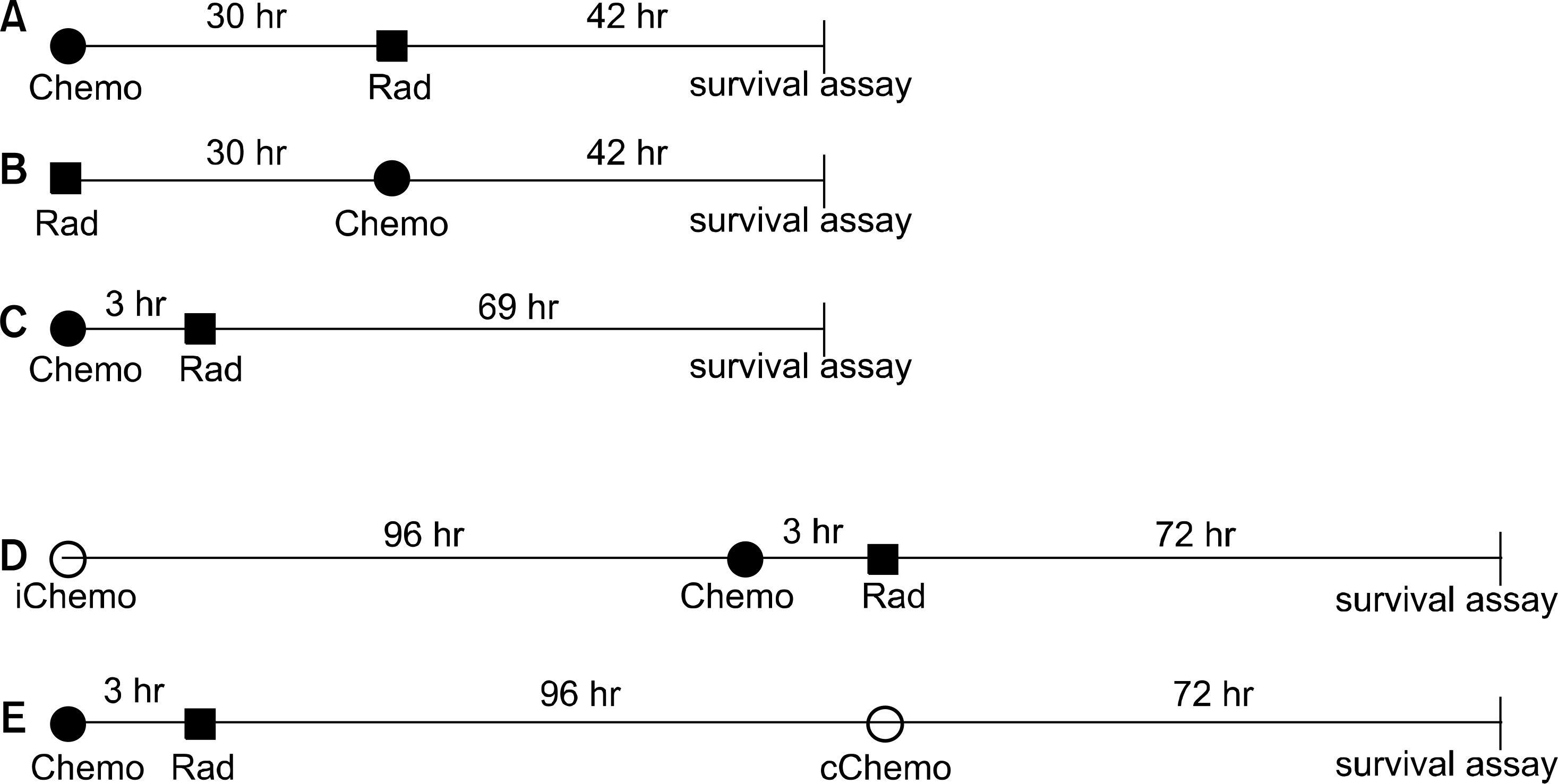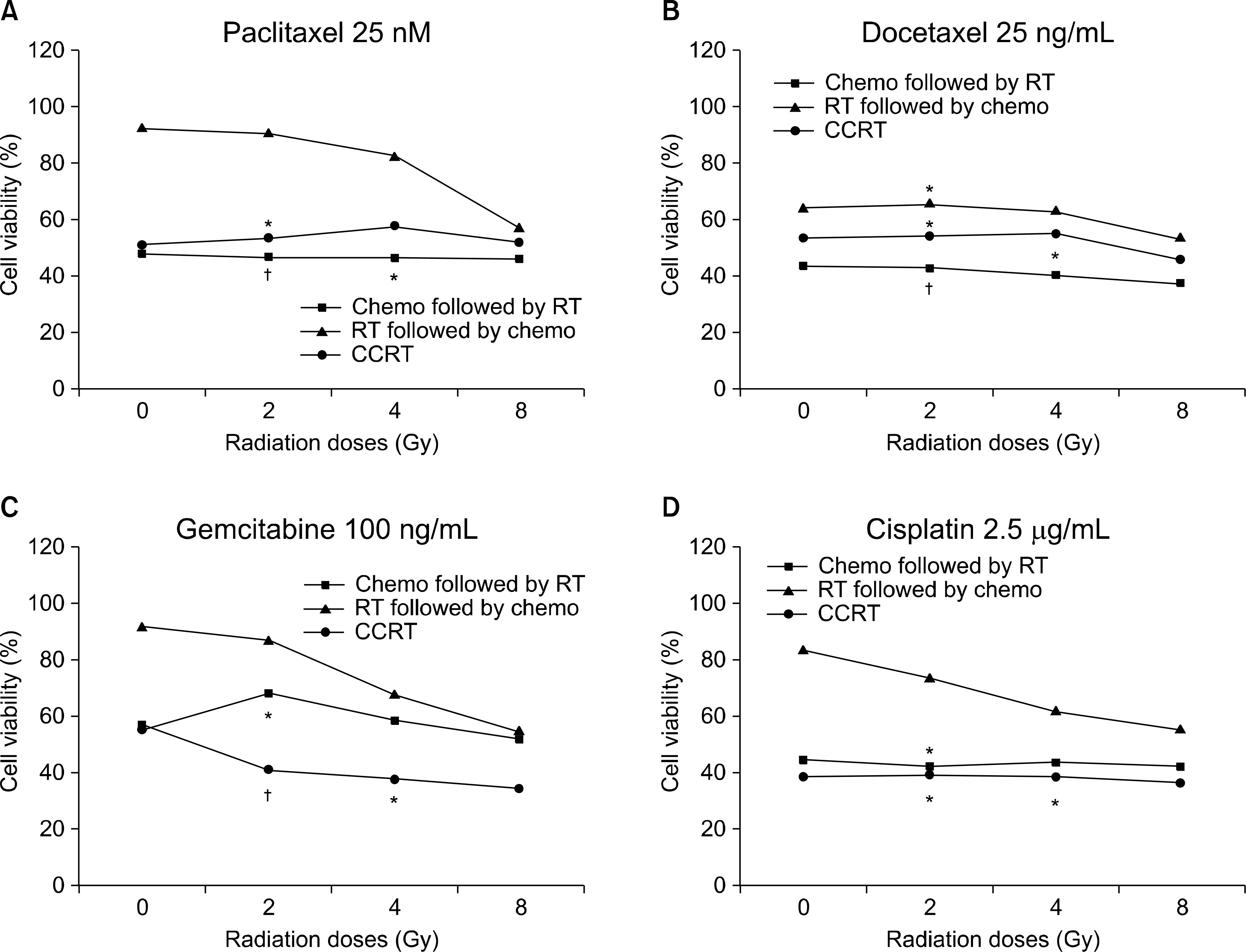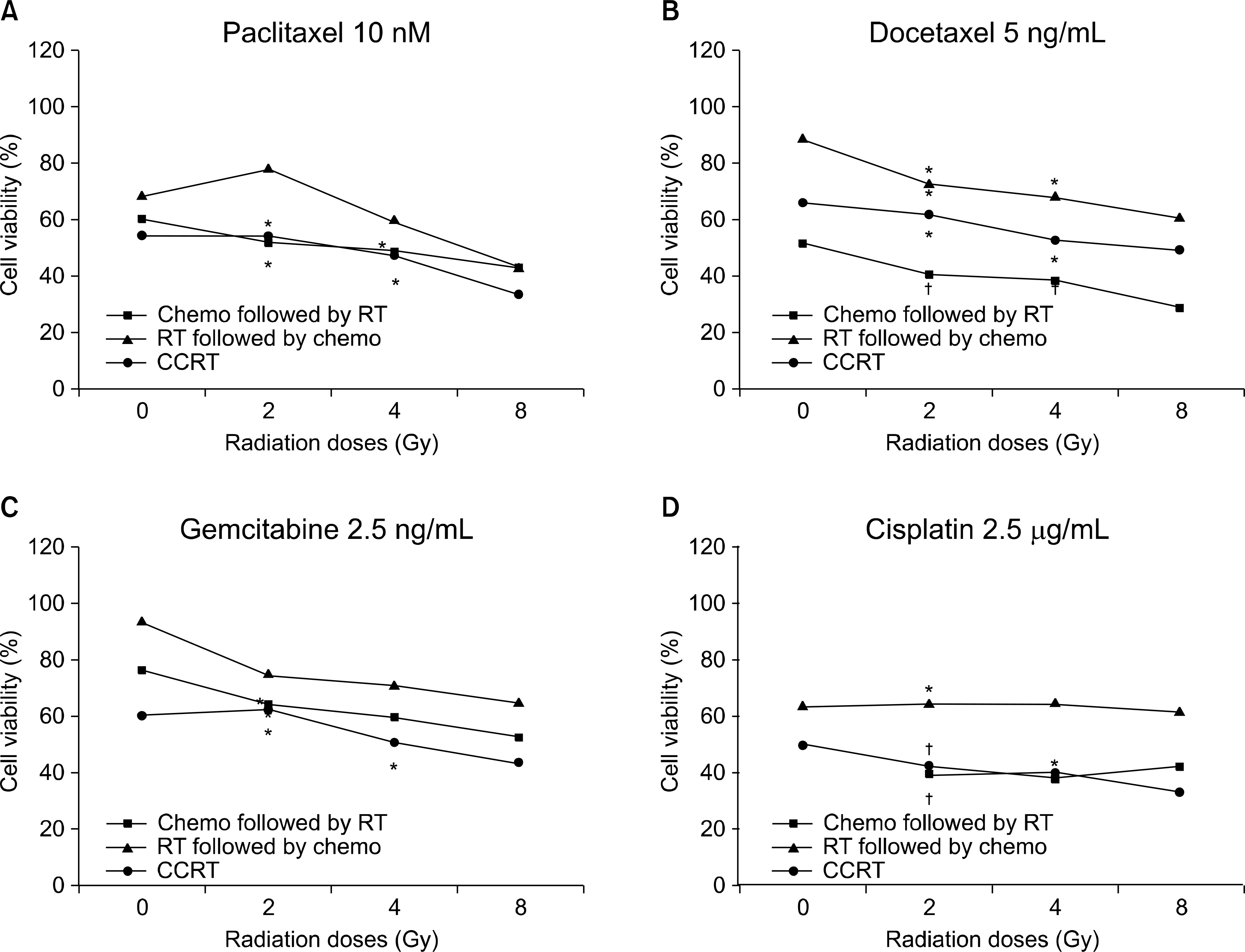J Lung Cancer.
2009 Jun;8(1):21-30. 10.6058/jlc.2009.8.1.21.
Investigating Effective Combinations of Anti-cancer Drugs and Radiation Therapy for Treating Non-small Cell Lung Cancer with Using Two Cell Lines
- Affiliations
-
- 1Department of Internal Medicine, Chonnam National University Medical School, Gwangju, Korea. kyc0923@chonnam.ac.kr
- 2Department of Radiation Oncology, Chonnam National University Medical School, Gwangju, Korea.
- KMID: 1464706
- DOI: http://doi.org/10.6058/jlc.2009.8.1.21
Abstract
-
PURPOSE: Radiotherapy had been used for treating unresectable locally advanced non-small cell lung cancer (NSCLC). However, the survival rate after radiotherapy alone is low and this primarily due to the failure of local disease control and distant metastasis. For achieving better disease control, radiotherapy has recently been combined with chemotherapy in various ways. In this study, we aimed to find the most effective combination of chemotherapy and radiotherapy for treating NSCLC.
MATERIALS AND METHODS
Two human lung cancer cell lines (NCI-H520 and A549) and various chemotherapeutic agents (paclitaxel, docetaxel, gemcitabine and cisplatin) were used for this study. The radiation doses were 0, 2, 4 and 8 Gy. After processing various combinations according to the radiation doses and the concentrations of thechemotherapeutic agents, cell survival was quantified by MTT (3-(4,5-Dimethylhiazol- 2-yl)-2,5-diphenyltetrazoliumbromide) assay. For the evaluation of synergism between chemotherapy and radiotherapy, we used a combination index that as calculated by Chou and Talalay's method and with using Calcusyn software.
RESULTS
Among the various combinations of chemotherapeutic agents and radiation doses, concurrent chemoradiation therapy (CCRT) led to the highest apoptosis rate and it showed frequent synergism. When taxane was administrated as a chemotherapeutic agent, chemotherapy followed by radiotherapy was the most effective combination. When high-dose chemotherapeutic agents were added to CCRT, induction chemotherapy resulted in a higher apoptosis rate and more frequent synergism than did consolidation chemotherapy.
CONCLUSION
When radiotherapy is combined with chemotherapy for treating the NCI-H520 and A549 cell lines, CCRT is the most effective combination. If a high-dose chemotherapeutic agent is added to CCRT, then induction chemotherapy is more effective than consolidation chemotherapy.
MeSH Terms
Figure
Reference
-
References
1. Curran W, Scott C, Langer C, et al. Phase III comparison of sequential vs concurrent chemoradiation for patients (pts) with unresected stage III nonsmall cell lung cancer (NSCLC): initial report of radiation therapy oncology group (RTOG) 9410. Proc Am Soc Clin Oncol. 2000; 19:A1891.2. Eberhardt W, Pö ttgen C, Stuschke M. Chemoradiation paradigm for the treatment of lung cancer. Nat Clin Pract Oncol. 2006; 3:188–199.
Article3. Fisher MD, D'Orazio A. Concurrent chemoradiotherapy followed by consolidation docetaxel in stage IIIB non small-cell lung cancer (SWOG 9504). Clin Lung Cancer. 2000; 2:25–26.4. Oh IJ, Ahn SJ, Lim JH, et al. A randomized prospective trial of concurrent chemoradiotherapy(CCRT) with paclitaxel or docetaxel or gemcitabine in stage IIIB nonsmall cell lung cancer. J Lung Cancer. 2007; 6(Suppl II):62.5. Jung JH, Kim HR, Kim EJ, et al. The role of heme oxygenase-1 in lung cancer cells. Tuberc Respir Dis. 2006; 60:304–313.
Article6. Lee YJ, Chung DY, Lee SJ, Ja Jhon G, Lee YS. Enhanced radiosensitization of p53 mutant cells by oleamide. Int J Radiat Oncol Biol Phys. 2006; 64:1466–1474.
Article7. Loprevite M, Favoni RE, de Cupis A, et al. Interaction between novel anticancer agents and radiation in nonsmall cell lung cancer cell lines. Lung Cancer. 2001; 33:27–39.
Article8. Ryu MR, Paik SY, Chung SM. Combined effect of heptaplatin and ionizing radiation on human squamous carcinoma cell lines. Mol Cells. 2005; 19:143–148.9. Tsutsumi K, Yasuda M, Nishioka T. X-ray irradiation altered chemosensitivity of a p53-null nonsmall cell lung cancer cell line. Cell Struct Funct. 2006; 31:47–52.
Article10. Zhang M, Boyer M, Rivory L, et al. Radiosensitization of vinorelbine and gemcitabine in NCI-H460 nonsmall-cell lung cancer cells. Int J Radiat Oncol Biol Phys. 2004; 58:353–360.
Article11. Chou TC. Drug combinations: from laboratory to practice. J Lab Clin Med. 1998; 132:6–8.
Article12. Chou TC. Synergy determination issues. J Virol. 2002; 76:10577. author reply 10578.
Article13. Morgillo F, Martinelli E, Troiani T, et al. Sequence-dependent, synergistic antiproliferative and proapoptotic effects of the combination of cytotoxic drugs and enzastaurin, a protein kinase Cβ inhibitor, in nonsmall cell lung cancer cells. Mol Cancer Ther. 2008; 7:1698–1707.
Article14. Bae JM, Won YJ, Jung KW, et al. Survival of Korean cancer patients diagnosed in 1995. Cancer Res Treat. 2002; 34:319–325.
Article
- Full Text Links
- Actions
-
Cited
- CITED
-
- Close
- Share
- Similar articles
-
- Role of Radiation Therapy for Non-small Cell Lung Cancer: Focused on Stereotactic Ablative Radiation Therapy in Stage I
- Molecularly Targeted Therapy for Lung Cancer : Recent Topics
- Management of Locally Advanced Non-small Cell Lung Cancer
- Enhancement of Cytotoxicity by the Combination of Anticancer Drugs in Human Lung Adenocarcinoma Cell Line (PC-14)
- Treatment of Small Cell Lung Cancer





